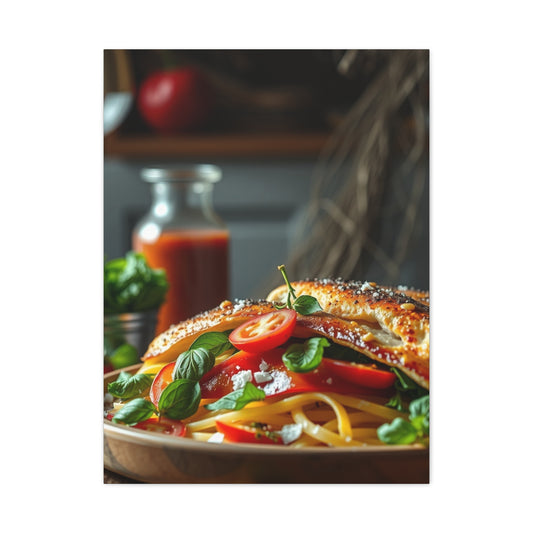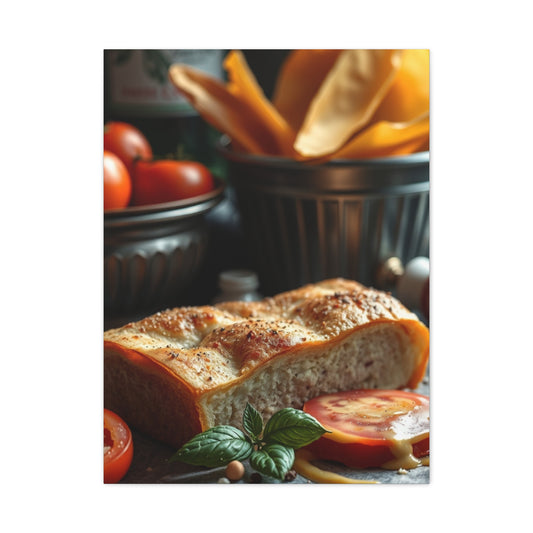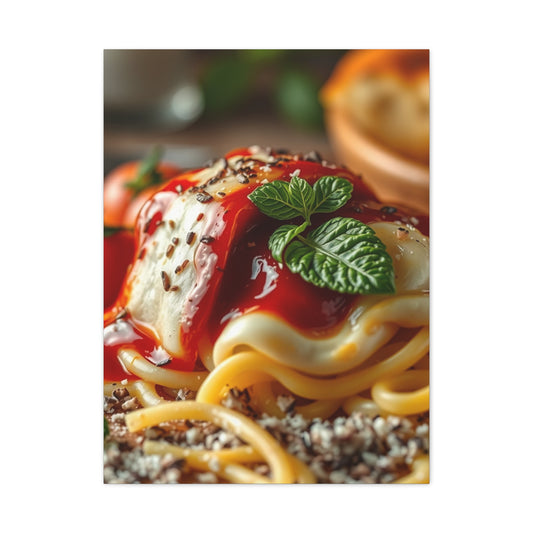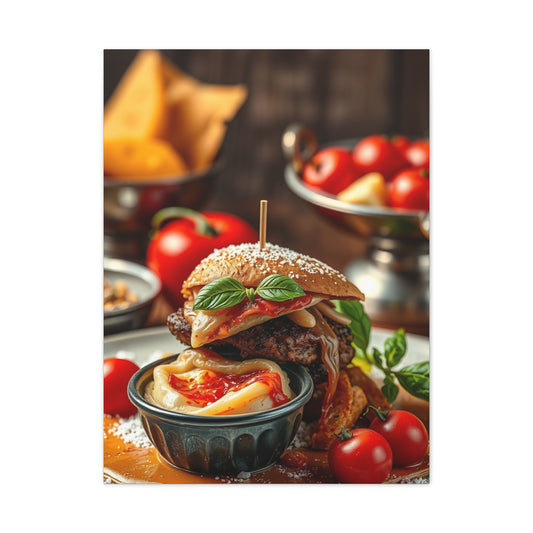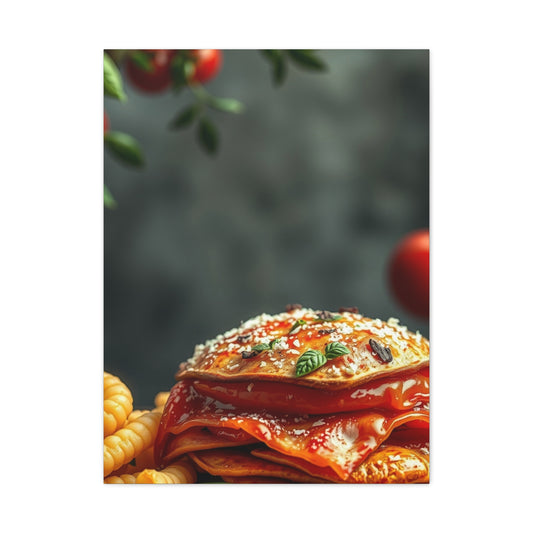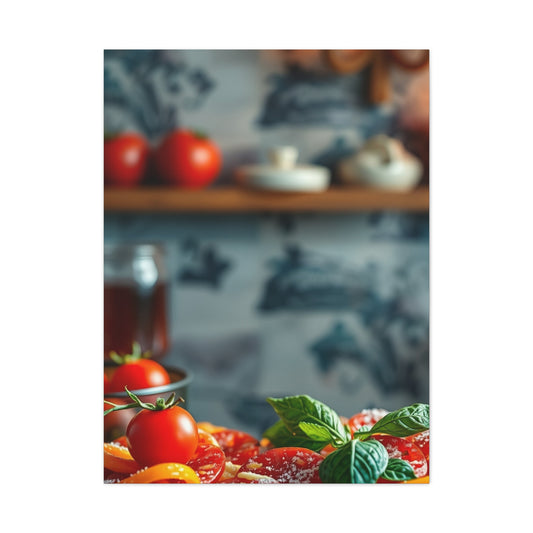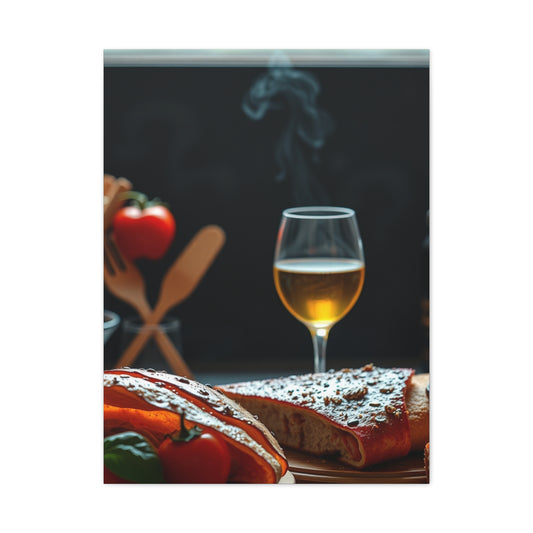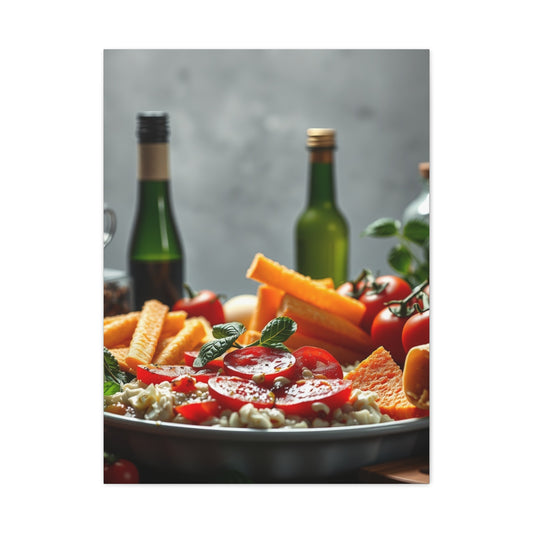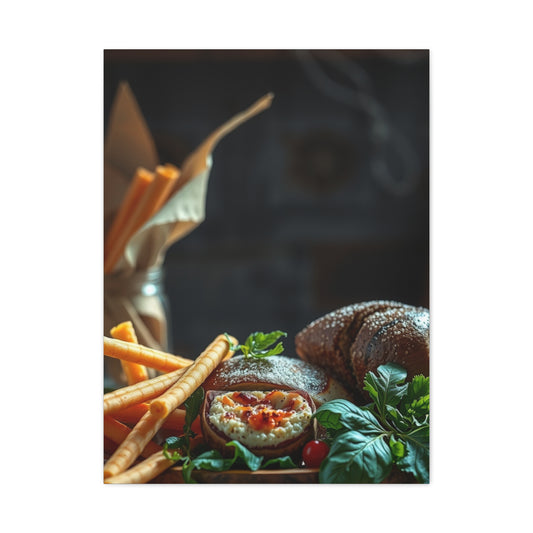Discover the Charm of Italian Food Wall Art for Your Kitchen
Throughout history, kitchens have represented far more than a place to prepare meals. They have always been the pulse of the home, where families gather, stories are shared, and traditions are passed from one generation to the next. In Italy, the kitchen has long been viewed as a sacred space, one where daily life and artistry converge. This profound relationship between food, family, and design is what makes Italian kitchen wall art so distinctive. It is never purely ornamental; it is deeply rooted in a cultural understanding that the kitchen should feel alive, soulful, and expressive.
Wall art in Italian kitchens embodies this philosophy by reflecting memories, landscapes, ingredients, and cherished culinary scenes. Each piece contributes not only to the beauty of the space but also to its role as a place of connection. The colors, textures, and themes chosen are intentional, designed to evoke warmth and familiarity while celebrating the artistry of Italian living.
The Historical Roots of Italian Kitchen Art
Italian art has always drawn inspiration from the environment, the countryside, and the vibrant rhythms of everyday life. The tradition of kitchen art can be traced back to the Renaissance, when frescoes adorned walls with abundant fruit, rustic meals, and bountiful harvests. These scenes were not merely decorative; they symbolized prosperity, gratitude, and the joy of life.
Over the centuries, Italian artisans continued to blend beauty with function, incorporating motifs from agriculture, winemaking, and regional cuisine. The kitchen became a natural canvas for these expressions. Depictions of olives, grapes, bread, and wine often carried symbolic meanings, representing sustenance, abundance, and togetherness. This heritage is still visible today, as modern Italian kitchen wall art borrows heavily from these historic traditions while adapting them to contemporary tastes.
Storytelling Through Visuals
One of the defining features of Italian kitchen wall art is its ability to tell stories. A painting of a Tuscan vineyard not only displays a picturesque view—it recalls the age-old tradition of grape harvesting, the scent of the soil, and the rituals of winemaking. A framed illustration of handmade pasta speaks to the labor of love that goes into Italian cooking.
Each image becomes a narrative, whether it portrays rolling hills of the countryside, bustling street markets, or a simple bowl of lemons on a rustic wooden table. For Italians, these depictions are never just images but visual memories that keep cultural identity alive. Even in kitchens far from Italy, the presence of such art allows individuals to create an atmosphere steeped in warmth and authenticity.
The Symbolism of Color and Form
Color plays an essential role in shaping the atmosphere of a kitchen, and Italian art is renowned for its vibrant palette. Deep reds mirror the richness of ripe tomatoes or fine wines, while greens symbolize the earthiness of olive groves and fresh herbs. Yellows recall the brightness of lemons, sunshine, and golden wheat fields. Together, these colors do more than decorate—they bring a sensory experience that reflects the vitality of Italian culture.
The forms used in Italian art are equally significant. Curves, flourishes, and natural shapes create a sense of movement and liveliness. Botanical motifs, rustic textures, and depictions of natural produce mirror the simplicity and generosity of rural life. This harmony of color and form is what allows Italian kitchen wall art to feel so immersive, transforming a plain surface into a reflection of cultural richness.
Regional Inspirations in Italian Wall Art
Italy is a nation defined by its regions, each with its own traditions, cuisine, and visual style. Tuscan art, with its golden fields and rustic farmhouses, often dominates kitchen themes because of its warm and earthy qualities. Sicilian influences, on the other hand, might feature bright citrus fruits, intricate ceramics, and coastal scenes that highlight the island’s vibrancy. Northern Italy brings imagery of vineyards, alpine landscapes, and hearty dishes reflected in cozy, pastoral scenes.
By drawing inspiration from different regions, Italian kitchen wall art can showcase a broad spectrum of cultural diversity. For example, a gallery wall might combine the sunlit vineyards of Tuscany with the bold citrus markets of Sicily, creating a lively fusion that captures the essence of the country as a whole. This variety ensures that there is no single definition of Italian art for the kitchen, only a wide and colorful array of interpretations.
The Relationship Between Food and Art
Food and art are inseparable in Italian culture. Meals are not just sustenance but expressions of love, creativity, and history. This deep reverence for food translates directly into the visual arts, where culinary motifs appear frequently. Paintings of bread, olive oil, cheese, and wine are not merely decorative—they symbolize the foundations of life and hospitality.
This artistic celebration of food extends beyond still-life paintings to more modern approaches. Vintage food posters, rustic chalkboard illustrations, and contemporary abstracts all serve to highlight the centrality of cuisine in daily life. Displaying these pieces in the kitchen is a way of honoring food itself, elevating it from a necessity to a cherished cultural emblem.
Wall Art as a Reflection of Personality
Choosing Italian kitchen wall art is not just about following tradition; it is also a way to reflect one’s personality. Some may prefer classical depictions of landscapes that evoke a sense of timelessness, while others gravitate toward bold and modern interpretations that inject energy and individuality into the space.
By curating specific pieces, homeowners can transform their kitchens into personal sanctuaries. A print of a bustling Italian marketplace might resonate with someone who enjoys vibrant social gatherings, while a serene Tuscan vista may appeal to those who value calm and simplicity. This personalization ensures that the kitchen remains an authentic expression of both cultural admiration and personal taste.
Practicality and Aesthetic Harmony
While the cultural and emotional aspects of Italian kitchen wall art are vital, practicality also plays a role in creating a balanced environment. The choice of frames, the placement of pieces, and the harmony of colors with cabinetry and countertops all determine the success of the decor.
Italian design values balance, and this principle applies to wall art as well. Overcrowding the walls can overwhelm the space, while too few pieces may leave it feeling bare. The art should complement the textures of the room, whether rustic wood, polished stone, or simple white surfaces. This careful blending ensures that the overall ambiance remains cohesive, making the art feel like a natural extension of the kitchen itself.
The Everlasting Appeal of Italian Wall Art
What makes Italian kitchen wall art so enduring is its ability to adapt without losing its essence. Whether displayed in a traditional countryside home or a modern urban apartment, it carries the same warmth, richness, and sense of belonging. Its themes are universal—family, food, nature, and beauty—which resonate across cultures and generations.
Even as styles evolve, the heart of Italian art remains rooted in its ability to connect people to their heritage and to one another. This timeless quality ensures that it continues to inspire and enchant, making it a perennial choice for kitchen spaces around the world.
The Emotional Power of Color
Color is not just an aesthetic choice; it is a powerful force that shapes the atmosphere of a kitchen. In Italian kitchen wall art, color carries a deeper cultural resonance. It reflects the vibrancy of Italian life, the richness of the landscape, and the warmth of family gatherings. A carefully chosen palette can instantly transport a viewer to a Tuscan vineyard, a Sicilian marketplace, or a rustic farmhouse bathed in golden light.
Italian wall art often employs a spectrum of hues that feel both grounded and lively. The fiery reds recall the ripeness of tomatoes and the depth of vintage wines. Greens draw from the olive groves, vineyards, and rolling hills that dominate much of the countryside. Yellows mirror the Mediterranean sun, the brightness of lemons, and the richness of wheat fields. These colors are not isolated; they work together to form an environment that is both comforting and invigorating, a balance that reflects the very essence of Italian culture.
The Warmth of Earthy Tones
Among the most prominent features of Italian art is the reliance on earthy tones. Shades of terracotta, ochre, sienna, and soft browns mirror the soil, the stone of ancient buildings, and the rustic materials used in traditional kitchens. These hues provide a grounding effect, connecting the artwork with the natural world and giving the space a timeless appeal.
When integrated into wall art, earthy tones establish a sense of stability. A painting with terracotta rooftops or rustic clay vessels resonates deeply because it captures the authenticity of Italian rural life. These tones also pair beautifully with wooden cabinetry, brickwork, or stone countertops, creating a seamless relationship between art and architecture.
Vibrancy Through Contrast
While earthy tones form the foundation, Italian wall art often thrives on contrast. Bold bursts of color highlight particular elements, making them stand out against a muted background. For instance, a still-life painting of lemons might feature radiant yellow fruit set against a subdued backdrop, allowing the brightness to symbolize vitality and freshness.
This balance between muted tones and vibrant highlights is essential to achieving harmony in Italian kitchens. It mirrors the dynamic interplay of tradition and innovation in Italian culture itself. Too much brightness can overwhelm the senses, while too little can leave the space feeling flat. The art achieves its impact by carefully orchestrating these contrasts, resulting in an atmosphere that feels both lively and harmonious.
Regional Color Variations
Just as Italian regions have distinct cuisines, they also have unique artistic palettes. In Tuscany, warm golds, deep greens, and earthy reds dominate, reflecting the landscapes of vineyards and fields. Sicilian art embraces brighter, more saturated colors—turquoise blues, citrus yellows, and bold oranges—that echo the island’s sun-soaked coasts and lively markets. Northern Italian styles, by contrast, often feature softer shades, inspired by Alpine scenery and cooler climates.
Incorporating regional color schemes into a kitchen allows for a more personal and varied expression of Italian art. A homeowner drawn to rustic warmth might lean toward Tuscan tones, while someone inspired by coastal energy could incorporate Sicilian hues. Each palette tells a different story while maintaining the overarching character of Italian style.
The Role of Texture in Visual Harmony
Beyond color, texture is an often-overlooked element that plays a significant role in Italian kitchen wall art. The brushstrokes of a painting, the grain of wood frames, or the weathered appearance of vintage prints all add depth and character. Texture provides a tactile quality, making the art feel alive rather than flat.
Rustic textures are particularly important in Italian kitchens, where authenticity is valued. A slightly distressed frame or a canvas with visible brush marks echoes the lived-in beauty of Italian homes. This sense of imperfection adds warmth, reminding us that kitchens are spaces of activity, creativity, and human presence.
Styles of Italian Kitchen Wall Art
Italian kitchen wall art does not belong to a single style; instead, it encompasses a wide variety of forms, each carrying its own charm. Traditional paintings, often featuring landscapes, still-life arrangements, or religious themes, connect kitchens to Italy’s long artistic heritage. Vintage food posters and illustrations capture the nostalgia of past eras, while contemporary pieces use abstraction or minimalism to reinterpret Italian motifs in a modern context.
For those who appreciate tradition, classic oil paintings or fresco reproductions bring grandeur and depth. For others seeking a lighter, playful approach, colorful prints of pasta shapes, espresso cups, or bustling markets may be more suitable. Each style offers a different perspective, yet all remain tied to the cultural essence of Italy.
The Balance Between Simplicity and Detail
Italian kitchen wall art thrives on the interplay between simplicity and detail. A minimalist line drawing of a wine bottle can be just as effective as a richly detailed painting of a vineyard, depending on the desired mood. Simpler pieces often highlight elegance and sophistication, while detailed works invite closer inspection, offering a narrative depth that evolves each time they are viewed.
The choice between simplicity and detail depends largely on the overall kitchen design. A sleek, modern kitchen may benefit from understated, contemporary pieces, while a rustic space might embrace highly detailed art that mirrors its textures and materials. Striking the right balance ensures that the artwork enhances the environment rather than overwhelming it.
Functional Aesthetics in Italian Art
A unique aspect of Italian kitchen wall decor is its embrace of functional aesthetics. Items like decorative clocks, chalkboards, or framed menus blur the line between utility and beauty. A chalkboard, for instance, may serve as a practical space for recipes or reminders while also carrying artistic illustrations of herbs or wine bottles.
This blend of practicality and artistry reflects the Italian philosophy of uniting form and function. The kitchen is not a gallery—it is a working space where meals are prepared, conversations unfold, and memories are created. Art that contributes both visually and practically is particularly well suited to this environment, ensuring that beauty does not come at the expense of usefulness.
Creating Harmony Through Placement
The placement of wall art is just as important as the art itself. Italian design emphasizes balance and proportion, and these principles apply to kitchen decor as well. A single oversized painting may dominate a space, creating a dramatic focal point, while a series of smaller prints arranged in a gallery style can add rhythm and variation.
Placement should also consider the architecture of the kitchen. A framed Tuscan landscape may look best above a dining nook, while playful illustrations of ingredients might work well near the cooking area. The art should complement natural sightlines and encourage the eye to move gracefully across the room. This thoughtful arrangement ensures that the kitchen feels cohesive, not cluttered.
Seasonal Adaptations of Color and Style
One of the advantages of Italian kitchen wall art is its adaptability to seasonal moods. Warmer tones and harvest-themed pieces may suit autumn and winter, while lighter, citrus-inspired artwork can brighten the kitchen during spring and summer. Some homeowners even rotate their artwork with the seasons, creating a space that evolves naturally throughout the year.
This seasonal approach not only refreshes the kitchen but also aligns with Italian traditions of celebrating seasonal ingredients. Just as menus change with the harvest, so too can the art reflect the cycles of nature. This practice enhances the sense of harmony between daily life, food, and design.
The Timeless Allure of Italian Aesthetics
At the core of Italian kitchen wall art is a timeless aesthetic that transcends trends. While modern variations come and go, the essence of Italian design—warmth, authenticity, and connection to life—remains constant. Its reliance on natural colors, regional inspirations, and a balance of beauty with function ensures its enduring appeal.
This timeless quality is why Italian wall art continues to be cherished across cultures. It speaks to universal values of hospitality, family, and joy in everyday rituals. Whether through vibrant color, rustic texture, or thoughtful composition, it elevates the kitchen from a functional space to a place of inspiration.
The Diversity of Expression in Italian Kitchen Art
Italian kitchen wall art cannot be confined to a single form or style. Its beauty lies in its variety, ranging from traditional framed paintings to playful decals and intricate murals. Each format carries its own atmosphere and impact, offering homeowners endless ways to shape the ambiance of their kitchens. Some approaches emphasize permanence and grandeur, while others favor flexibility and experimentation. Together, these different formats ensure that Italian-inspired art remains accessible to every type of space, whether expansive or modest, rustic or modern.
Framed Prints and Paintings
Framed artwork is one of the most enduring and versatile forms of Italian kitchen wall art. Whether it is a reproduction of a Renaissance masterpiece, a vintage food poster, or a contemporary photograph of Tuscan hills, the presence of a frame brings formality and structure. Frames themselves play a vital role in defining the mood: ornate gilded frames recall old-world elegance, while simple wooden ones evoke rustic authenticity.
Paintings and prints are especially effective for telling visual stories. A framed landscape of olive groves can make a kitchen feel open and expansive, while a close-up still life of bread and wine creates intimacy. The ability to rotate framed art or mix it with other pieces makes this format particularly adaptable, allowing the kitchen to evolve with changing tastes or seasons.
Murals as Immersive Statements
Murals stand apart as one of the most dramatic and immersive approaches to Italian kitchen wall art. Covering entire walls or significant sections, murals transform the kitchen into a visual journey. A hand-painted Tuscan countryside, with rolling hills and stone villas, can make even a small apartment feel like a retreat in rural Italy. Coastal scenes of the Amalfi cliffs or Sicilian markets bring vibrancy and energy, filling the space with life.
Murals often demand commitment, as they are not easily changed. However, their impact is unmatched. They create an atmosphere where every meal feels like part of a larger story. For those who want their kitchen to exude character and identity, a mural can be a defining feature that ties the entire space together.
The Flexibility of Wall Decals
For individuals who prefer a less permanent option, wall decals offer flexibility without sacrificing style. These adhesive designs can range from playful pasta illustrations to elegant botanical motifs. Unlike murals, decals are easy to apply and remove, making them ideal for renters or those who enjoy refreshing their decor frequently.
Italian-themed decals often feature olive branches, grapevines, or iconic culinary items such as coffee cups and wine bottles. They can be subtle, accenting corners or backsplashes, or bold, creating patterns across larger walls. Their temporary nature allows for experimentation, enabling homeowners to explore different looks without long-term commitment.
Gallery Walls as Curated Experiences
Gallery walls embody the spirit of curation, combining multiple pieces into a single cohesive display. This approach is particularly effective in kitchens, where smaller artworks can be grouped to create rhythm and variation. A gallery wall might include a mix of vintage posters, abstract paintings, rustic photographs, and even functional items like chalkboards or decorative plates.
What makes gallery walls compelling is their ability to tell layered stories. One section may highlight the pastoral beauty of Tuscany, while another captures the energy of an Italian marketplace. Together, the collection becomes more than the sum of its parts, reflecting not only Italian culture but also the personality of the homeowner. Flexibility is also inherent in this approach, as pieces can be rearranged or swapped over time to refresh the overall composition.
Functional Wall Art in the Kitchen
Unlike other rooms in the house, kitchens demand practicality. Italian design embraces this reality by integrating function with decoration. Chalkboards, clocks, shelving, and even utensil racks can become wall art when styled with intention. A chalkboard adorned with handwritten recipes and sketches of herbs contributes to both daily utility and artistic ambiance. A rustic clock with Roman numerals recalls traditional craftsmanship while serving a practical purpose.
Functional art highlights the Italian philosophy that beauty and usefulness should coexist. In a kitchen, where life unfolds daily through meals and gatherings, such pieces not only enhance visual appeal but also support the rhythm of daily routines. They remind us that art is not separate from life but woven into its very fabric.
Ceramic and Tile Artwork
Ceramic tiles hold a special place in Italian design, and their integration into kitchen walls offers both practicality and artistry. Hand-painted tiles depicting lemons, flowers, or geometric patterns bring bursts of color and texture. A tiled backsplash can serve as both a protective surface and a decorative focal point, showcasing craftsmanship that has been perfected over centuries.
In many Italian kitchens, ceramic art carries symbolic meaning. Lemons represent freshness and vitality, while grapevines suggest abundance and tradition. Tiles are also incredibly durable, making them a long-lasting choice for those who want art that withstands the daily activity of cooking. Their tactile quality enhances the sensory experience of the kitchen, adding richness beyond the purely visual.
Photographic Interpretations
Photography has become an increasingly popular medium for Italian kitchen wall art. High-quality prints of Italian landscapes, bustling markets, or traditional dishes capture moments of authenticity. Unlike paintings, photographs offer immediacy and realism, transporting viewers directly to the scene.
A photograph of a vineyard at dawn may evoke serenity, while an image of colorful Sicilian ceramics might inject energy and brightness. Photography also lends itself well to modern and minimalist kitchens, where clean lines and sharp visuals resonate with contemporary design. By choosing photographs that highlight personal connections or memories of travel, the kitchen becomes infused with intimacy and nostalgia.
Abstract and Modern Approaches
While tradition dominates much of Italian wall art, modern interpretations are equally significant. Abstract works that reinterpret the colors and shapes of the Italian landscape offer a fresh perspective. A canvas with broad strokes of sunlit yellow, olive green, and terracotta may not depict a vineyard literally, but still evoke its atmosphere.
Modern pieces are particularly effective in sleek kitchens where minimalism prevails. They demonstrate that Italian inspiration is not confined to the past but can adapt to contemporary aesthetics. The combination of tradition and modernity creates an exciting tension, ensuring that the art remains dynamic and relevant.
Seasonal and Rotational Displays
One of the advantages of using varied formats of Italian wall art is the possibility of seasonal rotation. A gallery wall may include frames that can be swapped with different prints depending on the time of year. In summer, bright citrus-themed art might dominate, while autumn calls for harvest scenes of grapes and wheat.
Rotating displays keeps the kitchen fresh and aligned with seasonal moods, much like how Italian cuisine itself changes with the harvest. This approach makes the art feel alive, not static, ensuring that the kitchen evolves with the cycles of life.
The Personal Touch of Handmade Art
Handmade art brings intimacy and authenticity into the kitchen. Local artisans or even family members may create pieces that reflect Italian themes, from hand-drawn sketches to embroidery or wood carvings. Such pieces carry personal value that mass-produced art cannot replicate.
Handmade wall art also connects directly with Italy’s tradition of craftsmanship. The imperfections of hand-painted ceramics or brushstrokes remind us of the human effort and creativity behind each object. Displaying such work in the kitchen underscores the idea that art and cooking share the same foundation: both are acts of creation rooted in love and dedication.
Combining Multiple Formats for Depth
The richness of Italian kitchen wall art often comes from combining formats rather than relying on a single type. A mural can serve as a dramatic backdrop, accented by framed prints or functional chalkboards. Ceramic tiles may line a backsplash while a gallery wall fills another section with varied textures and imagery.
This layering of formats creates depth, ensuring that the kitchen feels multidimensional. It reflects the Italian approach to life itself—complex, textured, and abundant. By blending styles, homeowners can achieve a space that feels curated, lived-in, and personal, rather than staged or artificial.
Understanding the Role of Balance
Balance is a fundamental principle in Italian kitchen wall art, and it extends far beyond mere aesthetics. It involves arranging colors, textures, and forms in a way that creates visual stability while maintaining a sense of liveliness. A well-balanced kitchen does not overwhelm the senses, nor does it feel sparse or incomplete. Instead, it exudes calm energy, inviting those who enter to linger, cook, and connect with the space.
In Italian culture, balance reflects the harmony between life and nature, tradition and innovation. A kitchen that embraces this philosophy is both functional and beautiful, where each piece of art complements the room rather than competing with it. Achieving such equilibrium requires careful consideration of scale, proportion, and placement.
Assessing Space and Proportion
Before adding artwork to a kitchen, it is essential to understand the dimensions of the walls and the overall spatial layout. Large, open walls may accommodate murals or oversized framed prints, while smaller kitchens benefit from compact pieces or a curated gallery arrangement.
Proportion is crucial to ensure that the art feels integrated rather than imposed. A small painting on a vast wall may appear lost, while an excessively large piece in a cramped space can dominate and disrupt flow. Italian design often relies on natural proportion, drawing inspiration from architectural features, furniture dimensions, and the rhythm of the kitchen’s functional zones.
Color Coordination and Cohesion
Achieving harmony requires attention to color coordination. Italian kitchen wall art frequently features vibrant hues—reds, greens, yellows—but these should interact gracefully with the room’s existing palette. Complementary tones can enhance warmth, while contrasts may be used strategically to draw attention to focal points.
For instance, a kitchen with wooden cabinetry may be enriched by art that mirrors natural tones, while a minimalist kitchen with white surfaces can embrace brighter, more saturated artwork to create energy and depth. The goal is cohesion, where the color scheme reinforces the overall mood without appearing forced or chaotic.
The Rhythm of Arrangement
Arrangement is key to creating a visually engaging kitchen. The human eye is naturally drawn to rhythm and repetition, which can be achieved by grouping artwork in clusters or aligning multiple pieces along horizontal or vertical axes. Gallery walls, for example, often rely on rhythm to provide structure. Even when pieces differ in style, color, or size, thoughtful spacing and alignment ensure a cohesive narrative.
The rhythm of the arrangement also includes variation. Alternating large and small pieces, mixing framed prints with functional decor, or incorporating murals alongside smaller accents can create movement across the visual field. This dynamic balance prevents monotony and allows the kitchen to feel alive.
Focal Points and Visual Anchors
Creating a focal point is an effective strategy for guiding attention and establishing visual balance. A large mural, an oversized framed painting, or a vibrant ceramic installation can anchor the room, giving the eye a starting point from which to explore surrounding elements.
Focal points should resonate with the kitchen’s function and personality. A mural of a Tuscan vineyard above the dining area provides serenity, while a bright illustration of citrus fruits near the prep zone brings energy. Secondary pieces can then complement the anchor, creating layers of interest without overwhelming the viewer.
Integrating Functional and Decorative Pieces
Italian kitchen wall art often combines practicality with aesthetics. Functional items—chalkboards, clocks, shelves—can be arranged alongside decorative pieces to maintain balance. These elements serve dual purposes, enriching the visual environment while supporting daily activity.
Successful integration relies on scale, texture, and color. A chalkboard with botanical sketches can sit comfortably beside a framed food illustration, provided that the tones and proportions complement each other. Similarly, decorative shelving with ceramic accents can bridge gaps between larger artworks, contributing to an overall sense of unity.
Using Symmetry and Asymmetry
Both symmetry and asymmetry play roles in Italian-inspired kitchen design. Symmetrical arrangements offer a sense of order and stability, ideal for traditional kitchens. For example, two framed prints flanking a window or a centered mural above a dining nook create formal elegance.
Asymmetry, by contrast, can introduce energy and spontaneity. A gallery wall with unevenly sized pieces, interspersed with functional items, and a mix of textures embodies a casual, lived-in atmosphere. Italian kitchen wall art embraces both approaches, recognizing that the choice between symmetry and asymmetry depends on the desired mood and spatial context.
Layering Textures for Depth
Texture adds depth to Italian kitchen wall art, making a space feel multidimensional. Combining smooth ceramic tiles with rough-hewn wooden frames, textured murals, and printed fabrics creates a tactile contrast that engages the senses. Even visual textures—such as the brushwork of a painting or the intricate detail of a photograph—contribute to the perception of depth.
Layering textures requires careful consideration of balance. Too many contrasting surfaces can feel chaotic, while too little texture can leave the room flat and uninspiring. Thoughtful layering enhances richness, making the kitchen feel both authentic and inviting.
Incorporating Natural Elements
Italian kitchens often draw inspiration from nature, and incorporating botanical or organic motifs can enhance harmony. Olive branches, grapevines, citrus trees, and rustic harvest imagery connect the kitchen to the outdoors, reinforcing the sense of vitality and freshness.
These natural elements can be represented in framed prints, murals, decals, or even functional pieces like hand-painted tiles. The recurring theme of nature not only unifies disparate pieces but also reinforces the traditional Italian belief that life and art are inseparable from the natural world.
Consideration of Light and Space
Lighting plays a pivotal role in the perception of Italian kitchen wall art. Natural sunlight amplifies the vibrancy of colors, while artificial lighting can be directed to highlight focal points or accentuate textures. Positioning artwork where light interacts harmoniously with it enhances its visual impact and contributes to the overall atmosphere.
Spatial awareness is equally important. Art should not impede workflow or crowd functional areas. Strategic placement ensures that each piece contributes to aesthetic pleasure without interfering with practical use, creating a seamless integration between beauty and functionality.
Seasonal and Rotational Strategies
Rotating artwork or adjusting displays seasonally can maintain a sense of freshness and balance. Spring and summer might favor lighter, citrus-inspired prints, while autumn and winter could bring warmer tones, rustic harvest imagery, or cozy Tuscan landscapes.
This rotation aligns with Italian traditions of celebrating seasonal ingredients and harvest cycles. It ensures that the kitchen evolves naturally throughout the year, reinforcing a rhythm that is both visually stimulating and culturally resonant.
The Emotional Impact of Curated Spaces
A carefully curated kitchen evokes emotion and sets the tone for daily life. Italian kitchen wall art does more than decorate; it creates an atmosphere that encourages conviviality, inspiration, and relaxation. Each piece, thoughtfully arranged, contributes to a narrative that engages the senses and fosters a sense of belonging.
Balanced curation allows the kitchen to function as a living canvas, where meals, gatherings, and moments of reflection occur against a backdrop of color, texture, and story. This emotional resonance is the hallmark of Italian design, emphasizing the kitchen as the heart of the home.
Personalization and Storytelling
Personal touches further enhance the harmony of Italian kitchen wall art. Family photographs framed alongside vintage prints, sketches from travels to Italy, or handmade ceramics create a space that reflects the homeowner’s identity. Art becomes a storyteller, weaving personal history into the cultural tapestry of the kitchen.
By curating pieces that resonate emotionally, homeowners can ensure that their kitchen remains authentic and inviting. The goal is not perfection but coherence—a space that feels alive, layered, and reflective of both culture and individuality.
Making the Kitchen a Reflection of Self
Italian kitchen wall art is not merely decorative; it serves as an extension of personality. Each choice, from color palette to imagery, can reflect individual tastes, memories, and cultural appreciation. By thoughtfully selecting art, homeowners transform their kitchen into a space that communicates identity, rather than just functioning as a meal preparation area.
Personal expression in the kitchen might be as subtle as a series of hand-painted ceramic tiles reflecting favorite ingredients, or as striking as a vibrant mural depicting Tuscan landscapes. Each piece contributes to a narrative that is uniquely yours. By blending traditional Italian motifs with personal touches, the kitchen becomes a canvas for storytelling, connecting everyday life with heritage and creativity.
Curating Themes that Resonate
A cohesive theme enhances the sense of personal expression while maintaining visual harmony. Themes can be drawn from regions, such as rustic Tuscan hills, Sicilian citrus markets, or Venetian canals. They can also center on culinary elements, featuring olive branches, wine bottles, fresh pasta, or artisanal bread.
Selecting a theme provides structure for combining multiple pieces, whether through framed prints, decals, murals, or functional art. It allows homeowners to explore diverse media while maintaining coherence. The theme should resonate emotionally, aligning with memories, travels, or simply the atmosphere you wish to cultivate in your kitchen.
Seasonal Adaptation of Art
Italian kitchen wall art thrives when it evolves with the seasons. Just as menus change to reflect seasonal ingredients, artwork can shift to complement the natural rhythm of the year. Bright citrus and botanical motifs can dominate spring and summer, reflecting renewal, light, and freshness. Rich autumnal hues, harvest imagery, and rustic tones evoke warmth and comfort during fall and winter.
Rotating art seasonally encourages creativity and keeps the kitchen dynamic. Decals and small framed prints are particularly effective for this purpose, allowing homeowners to refresh the space without significant effort or expense. Seasonal adaptation strengthens the connection between the kitchen, nature, and Italian cultural rhythms.
Integrating Art with Functional Design
A hallmark of Italian-inspired kitchens is the seamless blend of beauty and functionality. Art does not exist in isolation; it complements countertops, cabinetry, backsplashes, and kitchen tools. Functional pieces, such as chalkboards, decorative shelving, or ceramic racks, can serve both practical and aesthetic purposes.
For example, a chalkboard featuring hand-drawn herb illustrations not only provides space for notes and recipes but also enhances the visual charm of the kitchen. Ceramic racks or tile installations can display both tools and art, ensuring that every element contributes to the overall ambiance. Integrating art with function maintains harmony, reflecting the Italian philosophy that form and utility are inseparable.
Storytelling Through Layering
Layering different types of Italian kitchen wall art adds depth and complexity. A mural can form a dramatic backdrop, complemented by framed prints, functional chalkboards, and decorative ceramics. This layering encourages the eye to explore the space, discovering new details with each glance.
Layering also allows multiple narratives to coexist. One area of the kitchen might celebrate rustic harvests, another might highlight coastal vibrancy, and a third could feature abstract modern interpretations. Together, these layers create a multifaceted environment, reflecting the richness of Italian culture and personal experiences.
Color Harmony and Emotional Impact
Color continues to play a crucial role in expressing individuality and setting mood. Vibrant reds, sunny yellows, and earthy greens can be combined in ways that resonate with personal taste. The interplay of bold and muted tones allows for both visual stimulation and calming balance.
Italian wall art often draws from natural and culinary inspirations, making color choices intuitive. The red of ripe tomatoes, the green of olive branches, and the yellow of lemons or wheat fields evoke sensory memories of Italian landscapes and cuisine. By coordinating these hues with cabinetry, countertops, and other kitchen elements, the space becomes both aesthetically pleasing and emotionally evocative.
Creating Focal Points that Reflect Personality
Focal points are essential for anchoring the kitchen’s visual composition. A striking mural of Tuscan hills can establish serenity, while a cluster of framed prints of local markets or traditional dishes can convey energy and warmth. Choosing focal points that reflect personal experience or taste ensures that the kitchen is a genuine reflection of identity.
Secondary pieces should complement the focal point, reinforcing the narrative without overpowering it. A series of small functional art pieces, like decorative clocks or chalkboards, can enhance personality while maintaining balance. Strategic placement allows the kitchen to feel curated and intentional, not random or cluttered.
Incorporating Handcrafted and Local Elements
Handcrafted elements deepen the personal connection to Italian kitchen wall art. Artisan-made ceramics, hand-painted tiles, or wooden frames showcase skill, tradition, and authenticity. These elements often carry subtle imperfections, adding character and warmth to the space.
Including handcrafted pieces also supports a narrative of care and intentionality. They remind homeowners that beauty is not only visual but tactile and experiential. Local or handmade artwork creates a sense of intimacy, making the kitchen a space that feels lived-in and uniquely yours.
Balancing Tradition and Modernity
Italian kitchen wall art bridges the past and present. Traditional paintings and murals coexist harmoniously with modern, abstract interpretations. Vintage posters may share walls with minimalist prints, creating dialogue between eras.
This balance allows for personal expression to flourish. A kitchen can honor classical aesthetics while embracing contemporary tastes, blending historical reverence with innovation. Such integration ensures that the space remains dynamic, reflecting both cultural appreciation and individual creativity.
Gallery Walls as a Narrative Tool
Gallery walls are particularly effective for storytelling. By combining multiple formats—framed prints, functional chalkboards, decorative ceramics, or photographs—homeowners can craft a layered narrative. Each piece contributes a chapter, whether inspired by regional landscapes, culinary traditions, or personal memories.
Gallery walls also facilitate seasonal adaptation. Individual frames can be rotated or updated, keeping the story fresh and aligned with the changing atmosphere of the year. This flexible approach allows the kitchen to evolve while maintaining continuity in style and theme.
The Sensory Dimension of Art
Italian kitchen wall art engages multiple senses. Visual appeal is primary, but texture, placement, and thematic resonance contribute to an immersive experience. Textured tiles, rough-hewn wooden frames, and layered prints create depth and invite tactile exploration. Color and light influence perception and mood, while imagery evokes memories, taste, and even aroma through association with familiar foods and landscapes.
By attending to these sensory dimensions, the kitchen transcends functionality. It becomes a space of experience, emotion, and inspiration, reflecting the Italian understanding that beauty is inseparable from daily life.
Integrating Botanical Motifs
Botanical motifs are a recurring theme in Italian kitchen wall art. Olive branches, grapevines, herbs, and citrus trees bring freshness and natural vitality to the space. These elements can be integrated through murals, decals, ceramics, or framed prints.
Botanical imagery reinforces the connection between the kitchen and nature, a hallmark of Italian tradition. It also adds a timeless quality, ensuring that the art remains relevant and evocative regardless of changing trends.
Seasonal Food Imagery
Complementing botanical motifs, seasonal food imagery emphasizes the cyclical nature of Italian cuisine. Art featuring tomatoes, peppers, grapes, or lemons reflects not only visual beauty but also cultural practices tied to harvests and culinary rituals.
Rotating these pieces with the seasons maintains freshness in the kitchen, reinforcing both visual and emotional engagement. The presence of seasonal food imagery aligns the kitchen with the rhythms of life, enhancing authenticity and depth of experience.
Achieving Cohesion Through Repetition
Repetition is a subtle but powerful tool for achieving cohesion. Repeating colors, motifs, or textures across different pieces unifies the kitchen without rigidity. A recurring olive branch motif, for instance, can appear in tiles, prints, and decals, creating harmony across disparate formats.
Repetition allows individual pieces to retain uniqueness while contributing to a collective identity. It creates a rhythm that guides the eye and fosters a sense of continuity throughout the space.
The Emotional Reward of a Curated Kitchen
When Italian kitchen wall art is thoughtfully curated, it becomes more than decoration. It fosters a sense of pride, comfort, and inspiration. Cooking, dining, and gathering take on richer meaning as the space resonates with history, culture, and personal narrative.
A kitchen infused with art invites engagement and interaction. Guests may be drawn to details of a mural, to handcrafted ceramics, or to vibrant framed prints. These interactions deepen the connection between people, food, and environment, transforming daily routines into experiences imbued with warmth and creativity.
Conclusion
Italian wall art is more than decoration; it is a celebration of culture, creativity, and personal expression. Across centuries, Italian artistry has intertwined food, nature, and daily life, transforming kitchens into spaces of warmth and storytelling. From the vibrant color palettes inspired by Tuscan hills and Sicilian coasts to the diverse formats of murals, framed prints, decals, and functional art, every element contributes to an atmosphere that is both visually captivating and emotionally resonant. Thoughtful curation, balance, and integration allow homeowners to blend tradition with modernity, creating a space that reflects personality while honoring heritage. Seasonal adaptations and the inclusion of botanical or culinary motifs keep the kitchen dynamic and alive, reinforcing the rhythm of life and nature. Ultimately, Italian kitchen wall art transforms a utilitarian space into a sanctuary—where culinary creativity, family connection, and aesthetic beauty coexist in perfect harmony.

